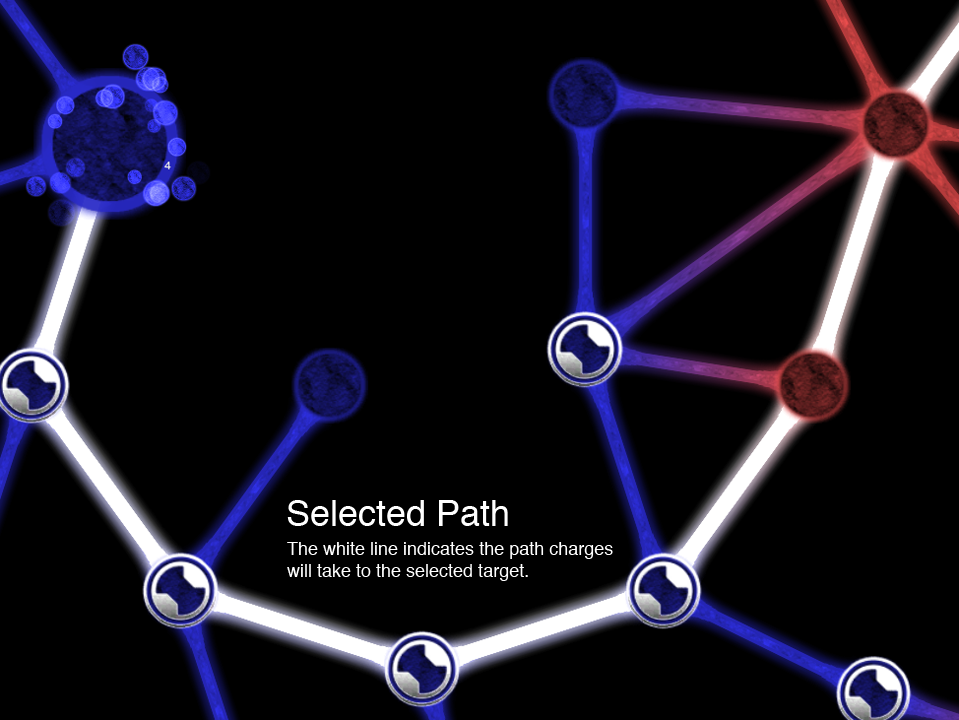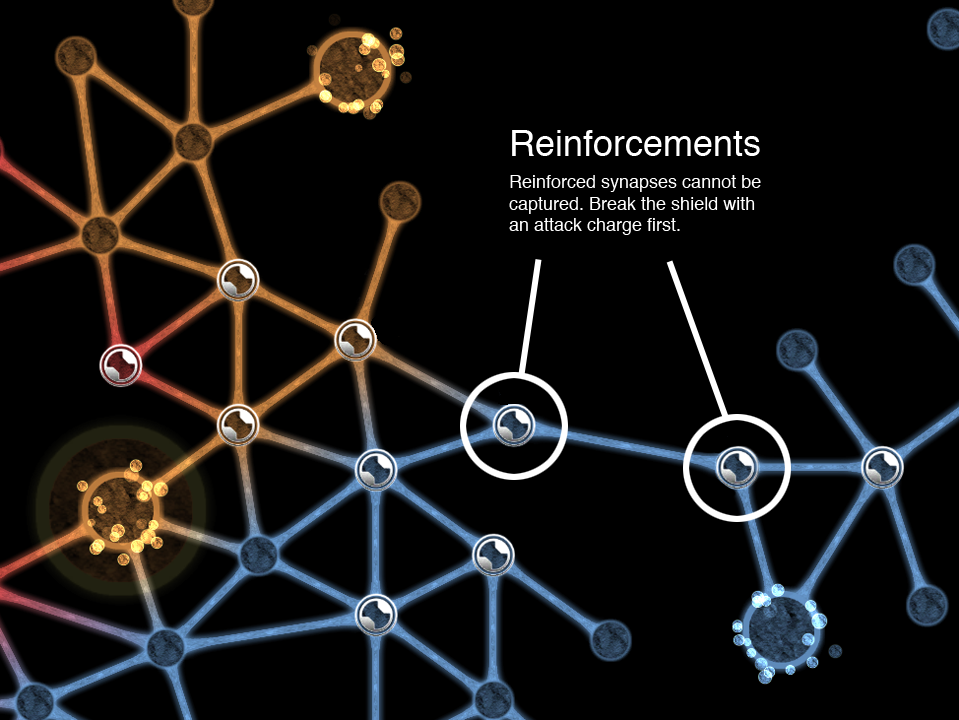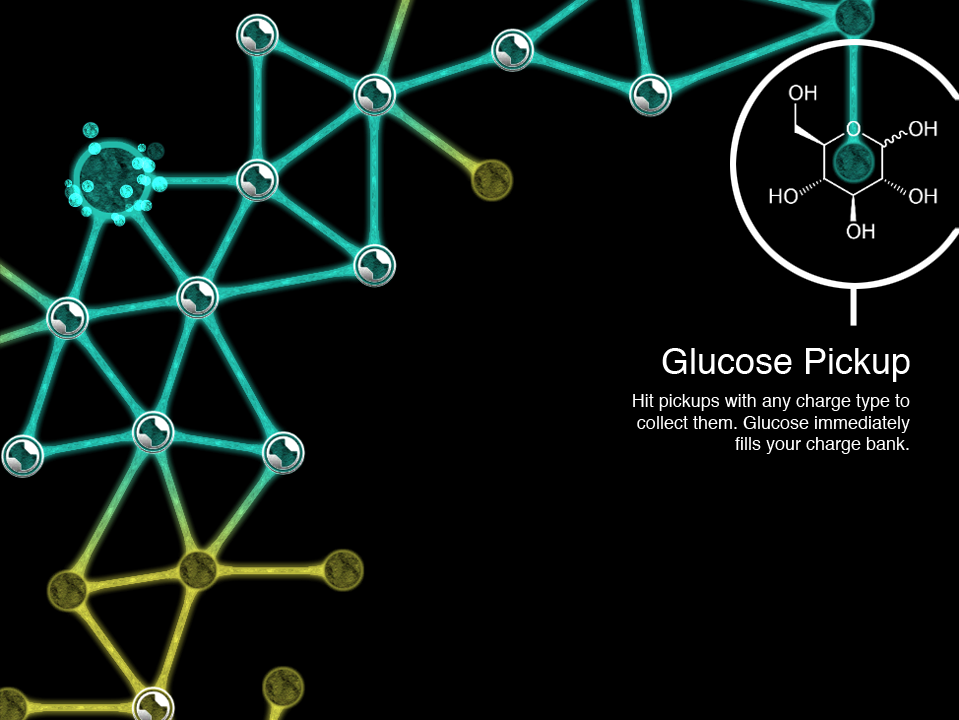Cortex
Cortex is an experimental, abstract real-time strategy game set inside the human brain. Using strategic emission of neurochemicals, you compete with other neurons for control of the entire neural network.





How To Play
The object of the game is to capture all opposing neurons and be the last player standing.
When you hold the mouse cursor over a synapse, you’ll see a highlighted path indicating the shortest path a charge can take to reach that point:
Charges always deploy from the nearest neuron (that you own). If you don’t see a highlighted path, then you either don’t have a connection to this synapse from any neuron, or you don’t have any charges available, which means you need to wait until one regenerates. The numbers next to your cursor tell you how many charges are ready to deploy and how much time remains before the next charge regenerates, respectively. (Don’t worry: they’ll get prettified in the final version.)
To deploy a charge, hold down the left mouse button to display the selector (which will also get prettified later):
You have four charge types to play with: attack, grow, reinforce, and capture:
- Attack charges trump other charge types and break synapse shields.
- Grow charges grow additional synapses and can capture multiple enemy synapses at once.
- Reinforce charges apply a shield to a synapse that prevents it from being captured.
- Capture charges are the only ones that can capture enemy neurons.
Reinforced synapses block your charges, and can’t be captured. You’ll need to break the shield with an attack charge first.
Occasionally, a pickup will spawn at a random location on the network. Hit it with any charge type to collect it and fill your charge bank immediately.
That’s all there is to it!
Postmortem
Cortex has been a really rocky project for me. I should open with an admission: the game isn’t really done, and I’ve abandoned it despite that. This postmortem, in part, will explain why.
The game began its life as a physics experiment with manipulating lattice-like structures, sort of like the towers and bridges of World of Goo. I didn’t have any particular design in mind; I was just messing around with an aspect of Unity’s physics system that I hadn’t explored before. After a while, a game began to suggest itself, not so much from the physicality of the lattice, but from the structure of the network itself. Thus, the first Cortex prototype was born.
Initially, I thought the game would have a more traditional RTS aesthetic: that the neurons would be bases, the synapses would be waypoints, and the charges would be infantry, tanks, and planes with a simple rock-paper-scissors relationship. Separately, I’ve become interested in the psychology of gameplay and game design, and it was about this time that my reading on the subject led me into neurochemistry.
Neurochemistry is a really fascinating, complicated subject, and the more I read about it, the more I realize it’s one of those subjects that’s way out on the frontier of known science. I’m fascinated by all kinds of natural phenomena—and the chemistry of the human brain certainly fits that bill!—and lately I’ve also been thinking a lot about how to steer my game design work toward explaining natural processes through simulation. Gaming is an incredibly effective way to learn things, and it bothers me that we as an industry haven’t been harnessing that power to show our audiences amazing things that are actually real.
So I decided—perhaps pretentiously—to model Cortex on neurochemistry. The idea was nice, but in practice this turned out to be a great big failure.
The problem is that neurochemistry is really messy. Natural processes usually are, but what makes it more difficult here is that there are so many holes in the science. I mentioned before that this is a sort of “knowledge frontier”. You can’t read a thousand words on the subject without coming across a “scientists have not yet reached a consensus” or “it’s still entirely unknown”. Formulating a game design around such incomplete science means I have to take a lot of artistic license to fill in the gaps.
For a concrete example, consider the charge types: attack, grow, reinforce, and capture. My original intent was to represent each of these as a specific neurochemical: adrenalin, dopamine, etc. I spent an inordinate amount of energy trying to work out a sensible mapping between real-world functions and in-game functions. For example, dopamine is most well-known for being a “pleasure chemical”: when something feels good, that’s dopamine at work. What’s the analog for that in the game design world of Cortex, though?
Dealing with that question for one neurochemical wasn’t so bad, but trying to come up with a full spread—considering we really know so little about what these substances do and how they work—proved to be impossible. The only way I could create this mapping would be to take an uncomfortable amount of license with what these chemicals do, and at that point the game is really just lying to you.
For me, making a game about natural processes requires a certain degree of real-world accuracy. Certainly license must be taken—SimCity dances around a lot of the nitty-gritty details of city management, for example—but the cardinal rule is “never teach something that is demonstrably false”. At that end of the spectrum lies Spore, which (inadvertently, I imagine!) teaches that evolution occurs when an intelligent mind makes choices about when and how species will evolve. I didn’t want Cortex to go that route, so I backed off from explicit neurochemical mapping and instead chose to imply the point: we might surmise there is some undiscovered neurochemical whose function is similar to Cortex‘s attack charge, and given the state of the science that’s not inconceivable (though I’ll admit it’s unlikely), so at least the game isn’t outright lying.
The issue of topical accuracy wasn’t the biggest problem that faced the game, though. After spending six months with this project, I’ve come to the conclusion that the core game design is irrevocably flawed. I had a lot of trouble getting past the first version, and while the second (and now final) version is a significant improvement in many ways, I still don’t find it fun. It’s not as simple as balance issues (which can be tuned) or adding a feature or two (not a big deal).
Let’s speak in traditional RTS terms for a moment, because Cortex is, fundamentally, a simple RTS. I don’t think that fielding infinite units—limited only by a production cooldown—leads to strategic gameplay. Instead, it promotes a stunted form of massing: you simply stream units toward your opponent as fast as possible, along the shortest possible route (which the game plots for you), and hope for a cooldown-boosting glucose pickup to break the inevitable stalemate. Furthermore, there’s no serious analog for base-building, which is a large part of what puts the “S” in “RTS”. The choices among unit types are limited, and the relationships between units are fundamentally uninteresting. Finally, there’s no real economy to speak of, literal or implied.
These are addressable problems, for sure, but they’re only addressable through a significant and fundamental redesign of the game. In short, to fix Cortex means to destroy it and create something entirely different in its place.
There is one critically important technique shared by every creative field, though they all have different names for it: the sketch, the treatment, the mockup, the prototype. Every creative field shares this concept because the signal-to-noise ratio of human creativity is pretty bad. Prototypes can be seen as a way to purge many bad ideas from your system, and thereby uncover the good ones.
The most important role of the prototype is failure, and the most important thing you must do when prototyping is recognize failure and immediately move on to the next idea. Cortex, in my estimation, is a failed prototype, but it’s one I stubbornly clung to for the better part of six months even though I knew it wasn’t working, and on some level, I knew it could never work.
How many legitimately good ideas might’ve emerged had I done what needed to be done when it needed to be done?
